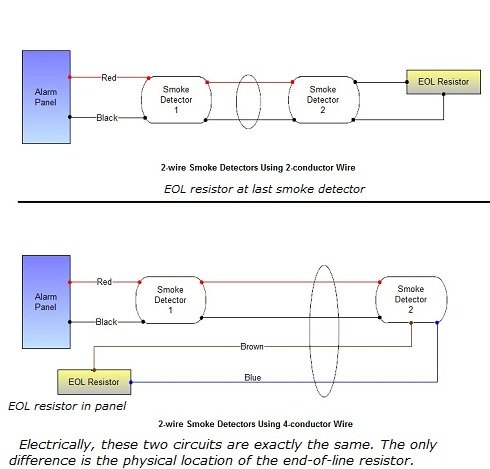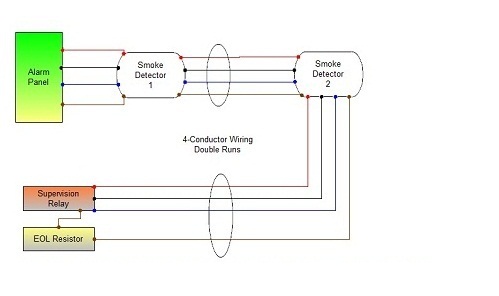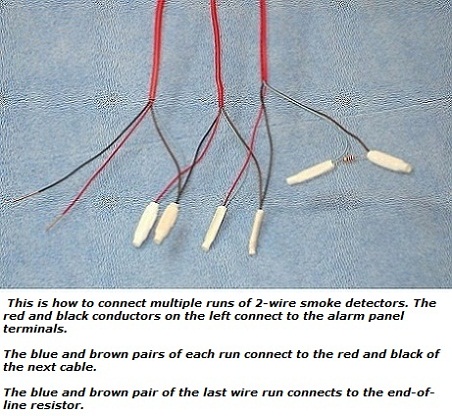- Home
- Compare Systems
- Cheap Systems
- Free Quotes
- DIY Systems
- Hardwired Systems
- Wireless Systems
- Smoke Detectors
- Medical Alarms
- Alarm Monitoring
- Cameras & Video
- Ademco
- ADT Security
- Brinks Security
- Broadview
- DSC Security
- FBI Alarms
- GE Security
- Honeywell
- Link Interactive
- Monitronics
- Moose
- Napco
- Protection 1
- Radionics
- Simplisafe
- Alarm Manuals
- Alarm System Parts
- Alarm Tools
- Troubleshooting
- FAQ
- Glossary
- Sitemap
- About Me
- Contact Me
Smoke Detector Wiring
Connecting Multiple Runs
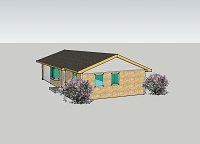
Adding smoke detector wiring for fire protection is a good way to get the most out of a hardwired home alarm system. For monitored systems, it can also earn you a bigger discount on your homeowners’ insurance. (For more on this, see the page on Home Security Alarm Monitoring).
If you don't have a home security system, you can still add hardwired and/or wireless smoke alarms.
First Alert has many choices for replacing old hardwired smoke alarms, as well as wireless units you can install as needed.For details, see "First AlertSmoke Detectors".
Kidde also makes smoke detectors
that don't require an alarm panel. They even offer a unit that lasts
for 10 years and never needs a battery change! Check it out at Kidde Smoke Detectors.
Alarm Panel Fire Zones
Although many of the home security systems in use today support the connection of smoke detectors, some only provide a single fire alarm zone. This usually means connecting all of the smokes in the home on a single wire run.
This is easy to do for a simple pitched-roof style, 3-bedroom,
2-bath tract home. These homes typically have plenty of attic space
across the whole house, and smoke alarm wiring can be looped from one
detector to the next pretty easily.
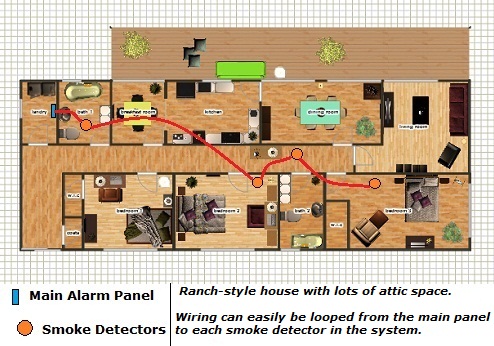
With some floor plans, smoke alarm placement can make running a single
smoke loop difficult if not impossible. Check out these examples:
Smoke Detector Wiring for Separated Areas
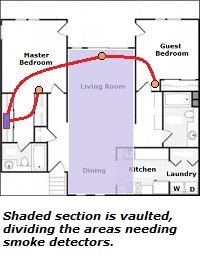
The floorplan above has a vaulted ceiling separating two sections, both of which require smoke alarm wiring.
Depending on how many devices are needed on each end, you may be
able to run everything on one wire. More often, there are several smokes
required for both sides. It’s then simpler to make a separate pull for
each side, leaving you with two wires to connect at the main panel.
Multi-Story Smoke Alarm Wiring
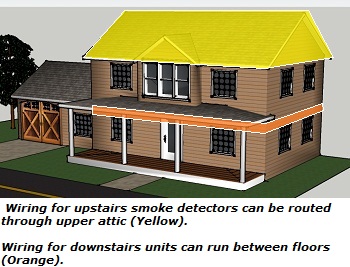
In this example, two different floors need smoke detector wiring.
Sleeping areas upstairs and down must be covered, and pulling a smoke
detector circuit for each floor is often the easiest solution.
If a basement is thrown into the mix, you may even need to pull three runs of smoke alarm wiring.
Wiring Smoke Alarms for a Detached Guest House
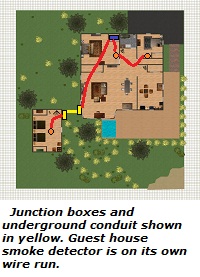
It’s a good idea to run detached buildings on their own smoke wiring.
Even if they could somehow be looped in with the main house smokes,
here’s a good reason not to do so:
Smoke alarm wiring (and all other wiring, for that matter)
usually connects from the main house to the detached guesthouse through
buried conduit. Moisture has a way of collecting in underground
conduits, and can cause deterioration and corrosion of the wiring. Smoke
detector problems like this can cause false alarms, aggravation, and
lost sleep…
If this happens, it’s much easier to troubleshoot the problem if the two
buildings have separate runs of smoke wiring. Also, if the problem is
in the conduit, the guest house run can be temporarily bypassed at the
alarm panel. This leaves the main house protected from fire while
repairs are made to the conduit and wiring.
Connecting Multiple Runs
Each of these scenarios results in two or more smoke detector wires
at the panel, with just a single fire zone to connect them to. What to
do?
The solution to this dilemma is simple:
Whenever possible, pull smoke detector wiring so as to place the supervisory devices at the panel, instead of at the end-of-line smoke detector.
This is done by using “extra” pairs of wires to provide a return
path from the last smoke in the run to the main alarm panel. This gives
the effect of one very big loop, when in fact there are multiple runs.
For 2 wire smoke wiring, this is done by using 4-conductor wire. 2-wire smokes only require 2 conductors, but adding the extra 2 conductors allows placing the end-of-line resistor at the panel.
See how this is done here:
Connecting 2 Wire Smoke Detectors.
For 4 wire smoke detector wiring, running an extra 4-conductor wire gives the same effect. The extra run of 4-conductor wire gives us a return path to the panel. This allows you to locate the end-of-line resistor and power supervision relay at the alarm panel.
For details on how to do this, see
Connecting 4 Wire Smoke Detectors.
To complete the wiring at the panel, simply connect the feed of the first detector run to the fire alarm zone terminals, as usual.
Next, splice the return loop of the first run to the feed wires of the second run. If there is a third, or even fourth or fifth run, just follow the same pattern.
When you get to the last run, the return wires of that run will
connect to the end-of-line resistor (and relay, for 4-wire smokes).
And you’re done! All of the smoke detector wiring is connected to the
fire alarm zone on the panel, and is fully supervised as if it were a
single run! (Because, technically, it is).
For additional details on making wiring connections to smoke detector terminals, check out
Smoke Detector Circuit Basics.
For guidelines on where to install smoke detectors, check out Smoke Alarm Placement for Home Security Systems.
For help finding problems with smoke alarm wiring, check out Smoke Alarm Circuit Troubleshooting for testing wiring at the main alarm panel.
For checking connections in the field, see
Troubleshooting Smoke Alarm Wiring at the Detectors.
If you're just thinking about installing a do-it-yourself alarm system, you may want to know how much a professional alarm company would charge. To find out, Get Free Home Security Systems Quotes from companies in your area. This will give you a good idea of what a system would cost to have installed, as well as how much you could save by doing it yourself!
Return to Home-Security-Systems-Answers from Smoke Detector Wiring
Return to Hardwired Home Security Systems from Smoke Detector Wiring
Return to Home Smoke Detectors from Smoke Wiring
Note: Feel free to print any of the articles on this site for personal, non-commercial use. Just look for this button:
If you found this website especially helpful, you might want to consider making a small donation. Since 2011, AzAlarmGuy has been providing free help and advice on home security systems to all of those in need.
Your gift, in any amount, will help me keep this website a free resource for anyone needing help with alarm system issues or questions.
Disclosure
I receive affiliate commissions from some of the companies and products I discuss. These commissions don't change the price that you pay.
Rest assured that this compensation does not influence my recommendations. I only endorse products and services that I truly believe to be an honest value for you, as a visitor to my site.
For more details, see my full disclaimer.
